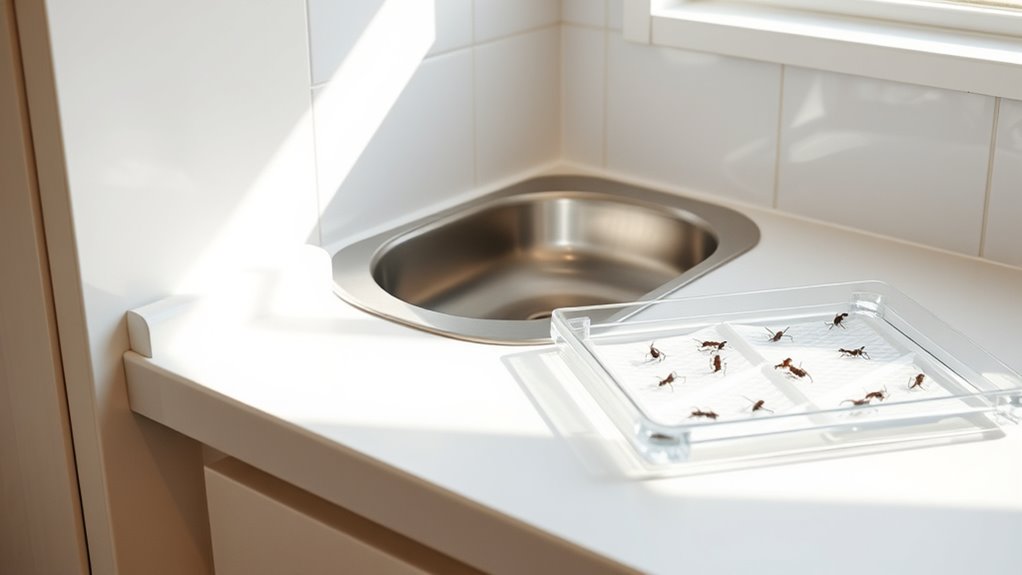To prevent pests, start by sealing all entry points, fixing gaps around pipes and vents with durable materials. Keep your home clean by storing food tightly and removing clutter that might hide pests. Regularly monitor your space with traps or detection devices to catch early activity. Maintaining dry environments and addressing moisture issues also make your home less inviting. For more detailed tips on each step, continue exploring effective pest prevention strategies.
Key Takeaways
- Seal all entry points, gaps, and cracks to prevent pest infiltration.
- Maintain cleanliness by storing food properly and eliminating crumbs and spills.
- Use pest monitoring devices and traps to detect early signs of infestation.
- Manage moisture by fixing leaks, ensuring proper drainage, and reducing humidity.
- Conduct regular inspections and reinforce barriers to sustain an effective pest prevention system.

Have you ever wondered how to keep pests from invading your home? One of the most effective methods is to focus on sealing entry points, establishing barriers, and maintaining a clean environment. Rodent barriers are essential because rodents can squeeze through tiny openings, so inspecting your home thoroughly and sealing gaps around pipes, vents, and windows is a vital first step. Use durable materials like steel wool or caulk to block these entry points, making it difficult for pests to get inside. Along with sealing, moisture control plays a significant role in pest prevention. Many pests, including cockroaches and termites, thrive in damp environments. Fix leaky pipes, ensure proper drainage, and use dehumidifiers in areas prone to excess moisture. Keeping your home dry deprives pests of the conditions they need to survive and reproduce, reducing their chances of establishing a presence. Additionally, utilizing pest monitoring devices can help detect early signs of pest activity before infestations become severe.
Once you’ve sealed potential entry points and managed moisture, it’s time to focus on ongoing maintenance. Regularly inspect your home for new gaps or cracks, especially after storms or renovations. Installing rodent barriers at likely entry points is a proactive way to prevent future invasions. These barriers act as physical obstacles that make it difficult for rodents to gain access, giving you peace of mind. Combine these physical barriers with moisture control strategies, such as venting damp areas and fixing leaks promptly, to make your home less inviting to pests. Remember, pests are attracted to food sources as well, so keeping your kitchen clean, storing food in airtight containers, and avoiding crumbs or spills can greatly reduce the likelihood of an infestation.
Monitoring is equally important. Set up traps or use pest detection devices in vulnerable areas to catch any early signs of intrusion. Regularly check these devices to identify pests before they multiply or cause damage. If you notice signs of pests despite your preventative efforts, act quickly by reinforcing barriers or consulting pest control professionals. Preventing pests isn’t a one-time task; it’s an ongoing process that requires vigilance, especially in areas where moisture is unavoidable or where small gaps might be overlooked. By sealing entry points with rodent barriers, controlling moisture, and keeping a close eye on potential trouble spots, you create an environment that’s hostile to pests. This proactive approach not only saves you from costly damage but also helps maintain a healthier, pest-free home.
Frequently Asked Questions
How Often Should I Inspect My Home for Pests?
You should inspect your home for pests at least once a month, especially during seasonal pest activity times. Regular checks help you spot signs of rodent proofing issues early and prevent infestations. Focus on sealing gaps, cleaning clutter, and monitoring entry points. By staying vigilant, you can catch problems before they escalate, making your home less attractive to pests and ensuring your prevention efforts remain effective year-round.
What Are the Most Common Household Pest Entry Points?
You should focus on common entry points like gaps around doors and windows, cracks in walls, and utility openings. These pest pathways allow insects and rodents to access your home easily. Make sure to seal gaps, repair damaged screens, and check for holes regularly. Monitoring these entry points helps prevent pests from entering, keeping your home pest-free and maintaining a clean, safe environment.
Are DIY Sealing Products Effective Against Pests?
DIY sealing products can be quite effective, acting like a sturdy shield against pests. You’ll want to focus on creating tight sealing barriers around windows, doors, and cracks, which can block their entry points. While DIY effectiveness varies—some products work well if applied correctly—it’s essential to make sure you seal all potential gaps thoroughly. Don’t forget, a well-placed barrier is your first line of defense, like a moat around a castle, keeping pests out.
How Can I Identify Early Signs of Pest Infestation?
You can identify early signs of pest infestation by observing unusual pest behavior, like sudden sightings or activity in hidden areas. Look for droppings, gnaw marks, or greasy smudges near potential pest breeding sites such as cracks, crevices, or clutter. Keep an eye on any strange odors or damage to food and packaging. Act quickly if you notice these signs, as early detection helps prevent a full-blown infestation.
What Natural Methods Complement Sealing and Cleaning?
Did you know that natural repellents can reduce pest presence by up to 60%? To complement sealing and cleaning, you should use natural repellents like peppermint oil or citrus peels around entry points. Organic traps, such as sticky traps or homemade bait stations, also help catch pests without chemicals. These methods create an eco-friendly barrier, making your home less attractive to pests and enhancing your overall prevention strategy.
Conclusion
Think of pest prevention like locking your door—it’s all about taking small, consistent steps. I once neglected sealing my pantry, and within days, tiny visitors arrived. That’s when I realized prevention is key: seal cracks, clean regularly, and monitor activity. Studies show that proactive measures cut pest problems by over 60%. Just like a fortress needs walls, your home needs these simple defenses. Stay vigilant, and pests won’t stand a chance against your proactive efforts.









